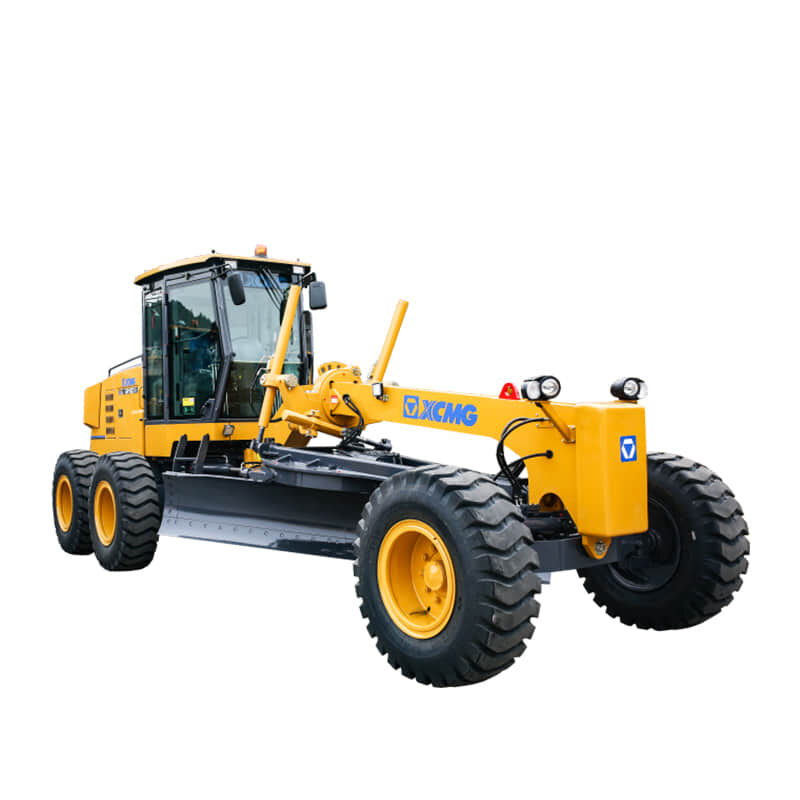I. Product Introduction
A motor grader, commonly known as a grader, is a crucial piece of heavy-duty construction machinery. It is mainly designed to level and grade surfaces such as roads, airfields, and large construction sites. Consisting of a long blade attached to the front, a cab for the operator, an engine that provides power, and a chassis with wheels or tracks, it can manipulate the blade's position and angle to cut, spread, and shape the ground precisely. With its unique functions and capabilities, it plays an essential role in creating smooth and even surfaces, ensuring the quality and usability of various infrastructure projects.
II. Product Advantages
- High Stability
-
- Sturdy Chassis Design
The chassis of the motor grader is engineered with a solid and robust structure. It is typically made of high-strength steel that can withstand heavy loads and the forces exerted during the grading process. The design distributes the weight of the machine evenly, which helps maintain stability even when operating on uneven terrains or while making sharp turns. For example, on a bumpy construction site, the sturdy chassis ensures that the grader stays firmly on the ground and continues to perform its leveling tasks without wobbling.
-
- Wide Wheelbase or Track Configuration
Motor graders usually feature a wide wheelbase or are equipped with tracks. A wide wheelbase provides a larger footprint on the ground, enhancing stability by reducing the risk of tipping over. In the case of tracked graders, the tracks offer better traction and grip on various surfaces, allowing the machine to move steadily and work with precision. Whether it's working on soft soil or a sloped area, the proper wheelbase or track setup keeps the grader balanced and stable.
-
- Advanced Suspension System
Many modern motor graders are equipped with an advanced suspension system. This system helps absorb shocks and vibrations generated during operation, further contributing to the overall stability of the machine. It allows the grader to maintain a smooth operation even when traversing over rough patches, ensuring that the blade remains at the correct position and angle for accurate grading.
- High Precision
-
- Precise Blade Control Mechanism
The blade of the motor grader can be controlled with remarkable precision. Operators can adjust the height, angle, and tilt of the blade with fine-tuned controls. There are usually hydraulic systems that enable smooth and accurate movements, allowing for the creation of very precise slopes and grades. For instance, when constructing a runway with strict grade requirements, the grader's blade can be manipulated to within a fraction of an inch accuracy to meet the exact specifications.
-
- Accurate Positioning and Guidance Systems
Some advanced motor graders are integrated with accurate positioning and guidance systems. These may include GPS technology or laser-guided systems that help the operator precisely position the grader on the work site. They provide real-time feedback on the machine's location and the alignment of the blade, enabling the operator to make corrections instantly and ensure that the grading work is carried out with the highest level of precision.
-
- Fine-tuned Operational Adjustments
Motor graders allow for various fine-tuned operational adjustments. Operators can control the speed of the grader and the cutting depth of the blade simultaneously, depending on the specific requirements of the project. This level of control ensures that the grading is consistent and uniform across the entire surface, whether it's a large parking lot or a long stretch of road.
- Good Compatibility
-
- Versatile Attachment Options
Motor graders can be equipped with a variety of attachments to expand their functionality. For example, rippers can be added to break up hard ground before grading, snow plows can be attached for winter maintenance, and scarifiers can be used to loosen compacted soil. These attachments make the grader suitable for different tasks and seasons, increasing its versatility and compatibility with a wide range of work scenarios.
-
- Compatibility with Different Materials
The motor grader performs well with various materials. It can handle everything from soft soil to gravel and even asphalt. Whether it's leveling a newly laid gravel road or smoothing out an asphalt surface for resurfacing, the grader's design and blade capabilities allow it to work effectively with different types of materials, adapting to the specific needs of each project.
-
- Interoperability with Other Construction Equipment
In a construction site, the motor grader can work in harmony with other equipment. It can cooperate with bulldozers to prepare the ground initially, then work alongside compactors to ensure the final surface is properly compacted. Its ability to integrate with other machinery makes it a valuable asset in complex construction projects, enhancing overall efficiency and workflow.
III. Product Application Scenarios
- Road Construction
In road construction projects, the motor grader is indispensable. It is used at the beginning to level the ground where the road will be built, removing bumps and irregularities. During the process of laying the base layer of gravel or crushed stone, the grader spreads the material evenly to create a flat surface. After the asphalt is laid, the grader can again be used to smooth out the surface, ensuring a consistent thickness and proper grade for safe driving. In every stage of road construction, the motor grader plays a vital role in achieving the desired quality of the road surface.
- Airfield Construction and Maintenance
For airfield construction, the precision of the motor grader is crucial. It is responsible for creating the precisely graded runways, taxiways, and aprons. The strict grade requirements for airfields mean that the grader's ability to maintain high accuracy is essential. During maintenance, the grader can also be used to repair any uneven areas on the runways or taxiways, ensuring the safety of aircraft takeoffs and landings. In airfield projects, the motor grader is a key piece of equipment that must meet the highest standards of performance.
- Large Construction Site Preparation
When preparing a large construction site, such as for building a factory or a commercial complex, the motor grader is used to level the entire area. It can clear away debris, shape the terrain according to the building plans, and create a flat and even surface for the foundation work. The stability of the grader allows it to work efficiently on large areas, and its compatibility with different materials means it can handle whatever soil or debris is present on the site. The motor grader helps set the stage for the rest of the construction process.
- Landscaping Projects
In landscaping projects, the motor grader is used to shape the land to create slopes, terraces, or gentle contours. It can move soil around to form beautiful garden beds or to create a smooth transition between different areas of a park or garden. The ability to control the blade precisely enables landscapers to bring their creative visions to life, making the motor grader a valuable tool for enhancing the aesthetic appeal of outdoor spaces.






